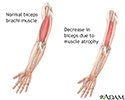Muscle aches
Muscle pain; Myalgia; Pain - muscles
Muscle aches and pains are common and can involve more than one muscle. Muscle pain also can involve ligaments, tendons, and fascia. Fascias are the soft tissues that connect muscles, bones, and organs.
Considerations
Muscle pain is most often related to tension, overuse, or muscle injury from exercise or hard physical work. The pain tends to involve specific muscles and starts during or just after the activity. It is often obvious which activity is causing the pain.
Muscle pain also can be a sign of conditions affecting your whole body. For example, some infections (including the flu) and disorders that affect connective tissues throughout the body (such as lupus) can cause muscle pain.
One common cause of muscle aches and pain is fibromyalgia, a condition that causes tenderness in your muscles and surrounding soft tissue, sleep difficulties, fatigue, and headaches.
Causes
The most common causes of muscle aches and pains are:
- Injury or trauma, including sprains and strains
- Overuse including using a muscle too much, too soon before warming up, or too often
- Tension or stress
Muscle pain may also be due to:
- Certain drugs, including ACE inhibitors for lowering blood pressure, cocaine, and statins for lowering cholesterol
- Dermatomyositis
- Electrolyte imbalance, such as too little potassium or calcium
- Fibromyalgia
- Infections, including the flu, Lyme disease, malaria, muscle abscess, polio, Rocky Mountain spotted fever, and trichinosis
- Lupus
- Polymyalgia rheumatica
- Polymyositis
- Rhabdomyolysis
Home Care
For muscle pain from overuse or injury, rest the affected body part and take acetaminophen or ibuprofen. Apply ice for the first 24 to 72 hours after injury to reduce pain and inflammation. After that, heat often feels more soothing.
Muscle aches from overuse and fibromyalgia often respond well to massage. Gentle stretching exercises after a long rest period are also helpful.
Regular exercise can help restore proper muscle tone. Walking, cycling, and swimming are good aerobic activities to try. A physical therapist or athletic trainer can teach you stretching, toning, and aerobic exercises to help you feel better and stay pain-free. Begin slowly and increase workouts gradually. Avoid high-impact aerobic activities and weight lifting when injured or while in pain.
Be sure to get plenty of sleep and try to reduce stress. Yoga and meditation are excellent ways to help you sleep and relax.
If home measures aren't working, your health care provider may prescribe medicine or physical therapy. You may need to be seen at a specialized pain clinic.
If your muscle aches are due to a specific disease, do the things your provider has told you to treat the underlying condition.
These steps may help lower the risk for getting muscle aches:
- Stretch before and after exercising.
- Warm up before exercising and cool down afterward.
- Drink lots of fluids before, during, and after exercise.
- If you work in the same position most of the day (such as sitting at a computer), stretch at least every hour.
When to Contact a Medical Professional
Contact your provider if:
- Your muscle pain lasts more than 3 days.
- You have severe, unexplained pain.
- You have any sign of infection, such as swelling or redness around the tender muscle.
- You have poor circulation in the area where you have muscles aches (for example, in your legs).
- You have a tick bite or a rash.
- Your muscle pain is linked with starting or changing doses of a medicine, such as a statin.
Call 911 or the local emergency number if:
- You have sudden weight gain, water retention, or you are urinating less than usual.
- You are short of breath or have difficulty swallowing.
- You have muscle weakness or cannot move some part of your body.
- You are vomiting, or have a very stiff neck or high fever.
What to Expect at Your Office Visit
Your provider will perform a physical examination and ask questions about your muscle pain, such as:
- When did it start? How long does it last?
- Where is it exactly? Is it all over or only in a specific area?
- Is it always in the same location?
- What makes it better or worse?
- Do other symptoms occur at the same time, like joint pain, fever, vomiting, weakness, malaise (a general feeling of discomfort or weakness), or difficulty using the affected muscle?
- Is there a pattern to the muscle aches?
- Have you taken any new medicines lately?
Tests that may be done include:
- Complete blood count (CBC)
- Other blood tests to look at muscle enzymes (creatine kinase) and possibly a test for Lyme disease or a connective tissue disorder
References
Best TM, Asplund CA. Exercise physiology. In: Miller MD, Thompson SR. eds. DeLee, Drez, and Miller's Orthopaedic Sports Medicine. 5th ed. Philadelphia, PA: Elsevier; 2020:chap 6.
Clauw DJ. Fibromyalgia, chronic fatigue syndrome, and myofascial pain. In: Goldman L, Schafer AI, eds. Goldman-Cecil Medicine. 26th ed. Philadelphia, PA: Elsevier; 2020:chap 258.
Long B, Koyfman A. Rhabdomyolysis. In: Walls RM, ed. Rosen's Emergency Medicine: Concepts and Clinical Practice. 10th ed. Philadelphia, PA: Elsevier; 2023:chap 116.
Review Date: 4/27/2023
Reviewed By: Linda J. Vorvick, MD, Clinical Professor, Department of Family Medicine, UW Medicine, School of Medicine, University of Washington, Seattle, WA. Also reviewed by David C. Dugdale, MD, Medical Director, Brenda Conaway, Editorial Director, and the A.D.A.M. Editorial team.

















